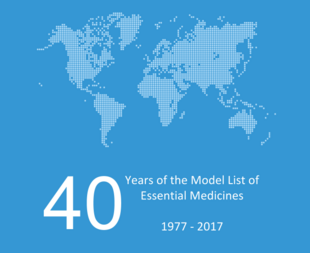Essential medicines

Essential medicines, as defined by the
Theory and practice
The definition of essential medicines has changed over time.
The original WHO definition in 1977 was that they were medicines "of utmost importance, basic, indispensable, and necessary for the healthcare needs of the population".
In 2002 definition was changed to:
Essential medicines are those that satisfy the priority health care needs of the population.[7]
And this remains the definition as of 2019[update].[1]
Selection
Items are chosen as essential medicines based on how common the disease that is being treated, evidence of benefit, the degree of side effects and the cost compared to other options.[8]
Cost-to-benefit ratio
History
The WHO Model List of Essential Medicines has been updated every two years since 1977. The 21st version was published in April 2019.[10]
Children's list
The first edition of the "WHO Model List of Essential Medicines for Children", was published in 2007, while the 7th edition was published in 2019.[5][4][10] It was created to make sure that the needs of children were systematically considered such as availability of proper formulations.[5] The first edition contained 450 formulations of 200 different medications.[5]
Number of medications
This section needs to be updated. (June 2019) |
The number of medications has nearly doubled, from the original 208 in 1977, to more than 340.
Society and culture
Access to essential medicines are part of the Sustainable Development Goals, specifically goal 3.8.[13]
A number of organizations, which are global in scope, use the list to determine which medications they will supply.[5]
See also
- Campaign for Access to Essential Medicines
- Universities Allied for Essential Medicines
- Department of Essential Drugs and Medicines
- List of World Health Organization Essential Medicines
References
- ^ a b "Essential medicines". World Health Organization (WHO). Archived from the original on October 2, 2008. Retrieved 20 January 2017.
- ^ "The Selection and Use of Essential Medicines (ss 4.2)". Essential Medicines and Health Products Information Portal. WHO Technical Report Series. World Health Organization (WHO). 2003. p. 132. Archived from the original on February 1, 2014.
- hdl:10665/325771.
- ^ hdl:10665/325772.
- ^ ISBN 978-3-642-20195-0.
- hdl:10665/153132.
- ^ "Trade, foreign policy, diplomacy and health". Essential Medicines. World Health Organization (WHO). Dec 6, 2010. Archived from the original on August 6, 2004.
- S2CID 23873145.
- ISBN 978-0-230-61195-5.
- ^ hdl:10665/325773. WHO/MVP/EMP/IAU/2019.05. License: CC BY-NC-SA 3.0 IGO.
- ^ "10 facts on essential medicines". World Health Organization (WHO). February 2010. Archived from the original on November 16, 2008. Retrieved 15 August 2015.
- PMID 23662019.
- PMID 27832874.
